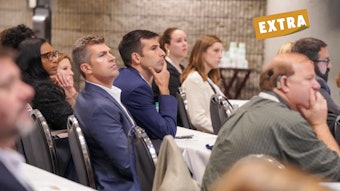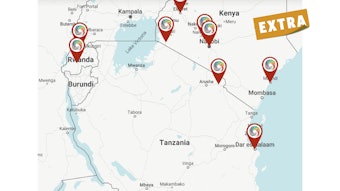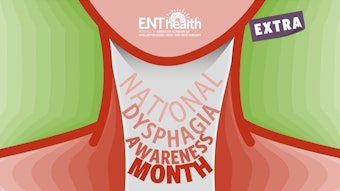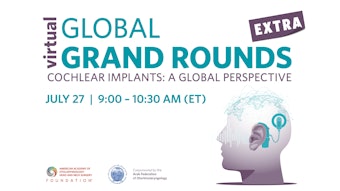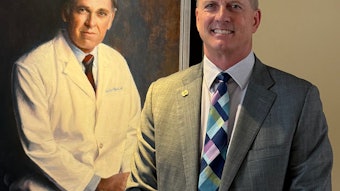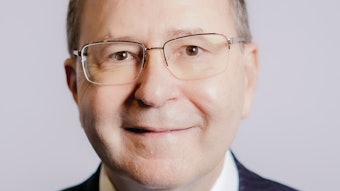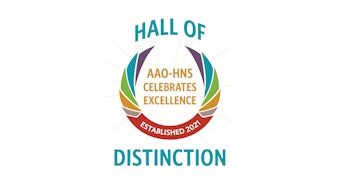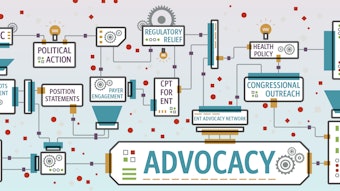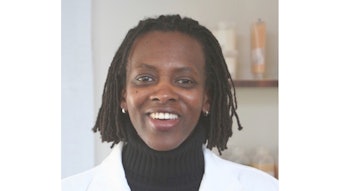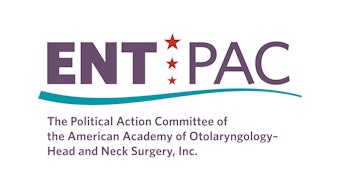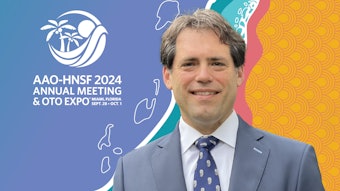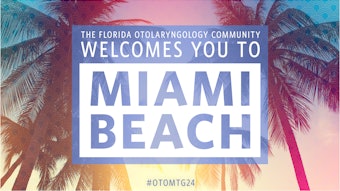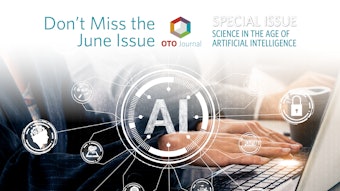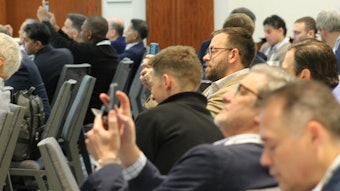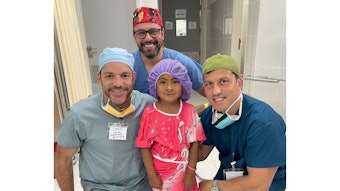Preparing for Your Individualized Extraordinary Experience at #OTOMTG24
Insider tips on key activities and how you can get the most out of your Annual Meeting experience.

 Daniel C. Chelius, Jr., MD, Annual Meeting Program Committee Coordinator
Daniel C. Chelius, Jr., MD, Annual Meeting Program Committee Coordinator
To navigate your way through all that the Annual Meeting has to offer, the following guest contributors provide their insider point of view about some of the important activities to attend and general suggestions for what to consider when creating your individualized extraordinary experience this fall: Michele Carr, DDS, MD, PhD, Christina Dorismond, MD, Amit Goyal, MS, DNB, MAMS, David E. Melon, MD, Hannah Kuhar Morrin, MD, Manan Shah, MD, and Yelizaveta (Lisa) Shnayder, MD.
For more insight into how you can prepare for your experience at the 2024 Annual Meeting, WATCH this informative panel discussion highlighting the exciting programming elements for students, residents, early-career physicians, women, those in or interested in private practice, international attendees, and more!
Preparing Students for the Annual Meeting
 Michele Carr, DDS, MD, PhD, Annual Meeting Program Committee member
Michele Carr, DDS, MD, PhD, Annual Meeting Program Committee member
Professor, Jacobs School of Medicine and Biomedical Sciences at the University at Buffalo
Most students who attend our Annual Meeting are there to present research, and they may not be aware of the abundance of other activities available to them. If you are connected to a student who is attending, there are some ways you can help them get the most out of the experience.
If you are an AAO-HNSF mENTor:
Our AAO-HNS mENTors perform a vitally important job with a major role in building the future of our specialty. If you are attending the Annual Meeting this year, arrange to meet your mENTee, even for a short time. You can plan to attend a ceremony, panel, lunch, or morning coffee. Take time to introduce them to your network. If you are not attending the meeting this year, try to find a friend or colleague who is and see if they’re willing to meet with your mENTee. As small a gesture it may seem as walking through the OTO EXPO with a doctor, it will be a cool, new experience for a student. Remember that some students in the mENTorship program have no home otolaryngology-head and neck surgery program and may be attending alone.
If you are an academic mentor:
As an academic mentor or research supervisor, consider doing a run-through of expectations for your student. Have them do their presentation live for you by adding them to the end of grand rounds in your department or having all the students meet after work to present their talks.
- Discuss potential questions they might receive.
- Talk about what they say when they get up to the podium, what to do if they make a mistake, and how to end a talk.
- Tell them to find the room early.
- Explain when to get their poster up, when it needs to be taken down, and what to expect in the Poster Hall.
- Tell them about ribbons. (They will wonder what’s going on when they start to see them.)
All these things may be background noise to the experienced attendee, but your student will appreciate the preparation. Don’t forget to circulate the fact that you have a student doing a presentation to your department so that they know to attend if schedules permit.
 Dr. Michele Carr (center, middle) and University at Buffalo medical students at the 2023 Annual Meeting.
Dr. Michele Carr (center, middle) and University at Buffalo medical students at the 2023 Annual Meeting.
Remember that attending an academic event far from home can be expensive. Tell your student about the AAO-HNSF Medical Student Travel Grants and investigate whether your department or local otolaryngology-head and neck surgery society is willing to subsidize their trip. Talk about costs early.
Pick out some talks and events that you think a student would enjoy—the Academic Bowl, for example—and share them with your student. Encourage them to attend the student-specific activities. This will include a SIM Center course, titled “Emergency Airway Management for Medical Students,” at 9:30 am (ET) on Sunday, September 29. The course requires some reading before attendance, and AAO-HNS student members will receive an email inviting them to participate. So, encourage all the student attendees to the Annual Meeting to join the Academy!
For all students:
The Academy has created sessions specifically for medical students during the Annual Meeting to hear from and meet with program directors, practitioners, and residents. These sessions include:
- Medical Student Speed Mentoring Event: Connect with leaders in the specialty with engaging discussions about the field and tips for successfully applying to residency programs. This is a highly anticipated event every year; sign up early during registration (no additional charge) to confirm your spot!
- Preparing for Your Residency Interviews Panel Presentation, 2:30 – 3:30 pm (ET), September 28: Gain insights from program directors and current residents on excelling in residency interviews. Discover expert tips and strategies to make a lasting impression during this pivotal stage of your medical career.
- Next Steps to Matching into Residency Panel Presentation, 8:00 – 9:00 am (ET), September 30: Learn how to stand out from the crowd during the residency application process in one of the most competitive surgical residencies. Gain valuable insights and perspectives from a panel of program directors representing diverse backgrounds and regions.
- Emergency Airway Management for Medical Students: Oto Chautauqua LIVE! 9:30 – 10:30 am (ET), September 29: This hands-on session designed for medical students focuses on emergency airway management. Students will rotate through three airway stations and perform various simulated procedures on a 3D model.
We also encourage you to explore the array of lectures and presentations, attend the General Assemblies of the Sections for Residents and Fellows-in-Training, Young Physicians, Women in Otolaryngology, and Otolaryngology Private Practice, participate as a guest in committee meetings of interest, and discover the most comprehensive display of the latest products and services in the OTO EXPO!
A Resident’s Perspective
 Christina Dorismond, MD, MPH, Annual Meeting Program Committee member
Christina Dorismond, MD, MPH, Annual Meeting Program Committee member
PGY3 Resident, Vanderbilt University, Department of Otolaryngology - Head & Neck Surgery
Over the past year, I have had the privilege of serving on the AMPC as a resident representative, and it's truly been an enriching experience. During my time on the committee, I have actively participated in discussions and decisions that mold the program into an enriching experience for all attendees. I have also had the opportunity to advocate for the resident perspective, ensuring that our interests are not only considered but integrated into the program’s design and execution.
Creating a program that seamlessly weaves together the diverse needs and interests of our specialty is paramount to the success of the meeting; and I have seen firsthand that it is no easy feat! With so many activities to choose from, the meeting app has been an integral aspect of my experiences in past years. I am excited for our updated app (coming soon!) that will help all of us make the most of our time at the meeting.
My advice to residents is to consider what you would like to get out of the meeting. If you would like to refine your clinical or surgical knowledge, consider attending Expert Lectures or Panel Presentations. If making new connections is a priority, plan to attend the Opening Ceremony and the Women in Otolaryngology Section or Section for Residents and Fellows-in-Training General Assemblies. If your focus is to be more up to date on the latest research, visit the Scientific Poster Presentations and listen to Scientific Oral Presentations. If exploring new technologies or getting hands-on experience is a goal, plan on visiting the OTO EXPO and participating in a Simulation Presentation.
Whatever your goals for the meeting, just as in residency, there is a way to make it happen with a little planning (and some help from the updated app). So, consider your priorities, plan, and don’t forget your walking shoes. See you in Miami!
Calling All International Attendees
 Amit Goyal, MS, DNB, MAMS, Annual Meeting Program Committee member
Amit Goyal, MS, DNB, MAMS, Annual Meeting Program Committee member
Professor at The All India Institute of Medical Sciences, Jodhpur
It is always quite exciting to be an international attendee at the AAO-HNSF Annual Meeting, whether you are a first-timer or have attended previously. It gives ample opportunities for professional development at every stage of one’s career.
The Annual Meeting is a single event that provides a platform for all ENT clinicians and allied professionals to showcase their work and offers an ideal environment for mutual learning and networking. Equally important, the Annual Meeting creates the space to learn about the latest concepts and trends in the field.
The networking lounges and dinners should be used to their full capacity, where one can learn and meet who is who among our vast global community. Enough business cards should be in your wallet at all times. I advise my international colleagues to contact the leaders and friends who you want to meet with in advance and schedule a time to catch up before everyone’s schedules are full.
Some opportunities at the meeting (other than scientific sessions) include:
- Attending meetings that discuss different aspects of diversity in medicine like gender, socioeconomic status, and ethnicity.
- Interacting with journal editors and authors published in top journals.
- Exploring the OTO EXPO, which provides a real-time sense of technological advancements that might not be available in your market. And this includes many hands-on opportunities to test the latest equipment!
- Exploring networking and funding opportunities for exposure to ideas, projects, and products.
Before the meeting Dr. Amit Goyal testing a robotic surgical system at the OTO EXPO.
Dr. Amit Goyal testing a robotic surgical system at the OTO EXPO.
All the above is necessary so that one can focus entirely on the scientific knowledge and networking opportunities during the days of the meeting. Overloading the brain by attempting to attend all the sessions and learn everything is not good for one’s health—that’s why planning which scientific sessions to attend is also important. Take advantage of the ample information provided by the Academy about the venue and sessions to plan your scientific feast in advance.
Learn, teach, meet, greet, eat, drink, and dance—happy conferencing!
Maximizing Your Experience from A Private Practice Perspective
 David E. Melon, MD, Otolaryngology Private Practice Section Chair
David E. Melon, MD, Otolaryngology Private Practice Section Chair
President, Carolina ENT Sinus and Allergy Center, P.A, Hickory, North Carolina
As a private practice otolaryngologist, attending the AAO-HNSF Annual Meeting & OTO EXPO is an invaluable opportunity for professional growth, networking, and staying abreast of the latest advancements in the field.
But just showing up won’t cut it. With so much on offer, you should anticipate the need to do some planning to extract the most value from this amazing event.
 One of the many well-attended Coffee Talks sponsored by OPPS during the 2023 Annual Meeting.
One of the many well-attended Coffee Talks sponsored by OPPS during the 2023 Annual Meeting.
Focus: Define specific goals for attending the conference. Is your primary objective honing clinical knowledge, networking with colleagues, or exploring the business of medicine?
Plan: Review the conference itinerary well in advance and prioritize sessions, workshops, and presentations that align with your primary interest.
Educate: Consider preconference reading. To keep abreast of emerging trends and research in the field, brush up on some material ahead of time to refamiliarize yourself with the speakers and key concepts.
Optimize
Participate: Don’t be reluctant to engage. Be active in sessions, participate in discussions, and exchange insights with peers. This not only enhances your learning but is also an opportunity to expand your professional contacts.
Network: Leverage networking events, such as receptions and social gatherings sponsored by the Otolaryngology Private Practice Section (OPPS). Don’t miss the OPPS General Assembly!
Explore: Visit the OTO EXPO to discover the latest technologies relevant to your practice. Evaluate products and seek out live demonstrations to inform purchasing decisions.
Engage: There are unique opportunities for hands-on training that you may not get in everyday practice. Seek out training sessions tailored to your areas of interest or areas where you seek to enhance or expand your skills.
Reflect and Act
Review: Take some time to actively reflect on your experience. But don’t give it too long. Do this shortly after the meeting while things are still fresh.
Connect: Reach out to individuals you met during the conference and explore potential collaborations.
Implement: Incorporate key learnings, strategies, and best practices acquired during the conference into your clinical practice. Make it a priority to bring actionable initiatives back to your practice.
Attending the Annual Meeting offers private practice otolaryngologists a unique opportunity for growth, learning, and professional advancement. By preparing diligently, actively participating, and leveraging networking opportunities, private practitioners can be sure to maximize their experience in the Magic City.
Expanding a Foundation of Learning for Residents
 Hannah Kuhar Morrin, MD, Section for Residents and Fellows-in-Training Chair
Hannah Kuhar Morrin, MD, Section for Residents and Fellows-in-Training Chair
Resident, Ohio State University Department of Otolaryngology–Head and Neck Surgery, Starting July 1, Facial Plastic and Reconstructive Surgery Fellow at L&P Aesthetics, Palo Alto, California
The Annual Meeting is an amazing opportunity for residents to expand their foundation of learning and network in the field of otolaryngology-head and neck surgery. There are several important considerations for residents when it comes to preparing for the Annual Meeting.
First, residents should plan ahead. If a resident has had a Scientific Oral or Poster Presentation accepted at the meeting, or if there are an allotted number of meetings they are allowed to attend, there may be funds available through their individual residency program. There are additional funding resources for residents, including grants to apply for through the Academy website. Housing books up quickly, so it is helpful to figure out housing and transportation early on.
Ahead of the conference, it is useful to go through the schedule online or through the Annual Meeting app to map out various education sessions or presentations that residents may wish to attend in person. There are multiple “program tracks” including all subspecialties, private practice, and professional development that residents may use to focus or broaden their selection of what to attend. Residents can be strategic about selecting these sessions depending on their personal or career interests. Attending the talk of a potential mentor, program, or fellowship director may also allow you the opportunity to connect with these individuals in person. Residents should also take advantage of the opportunity to meet with potential programs in person by reaching out to directors ahead of time. When deciding which sessions to attend, keep in mind that Scientific Oral Presentations are recorded and available on demand for three years for all full registrants. So, you don’t need to worry too much about choosing between conflicting sessions.
Second, residents should engage—whether by participating in the Student Networking session, attending the Women in Otolaryngology Section General Assembly, or trying out Simulation education events among the hundreds of presentations and opportunities available. Residents should take advantage of every opportunity of having otolaryngologists from around the world come together to learn, mentor, and make new connections. There are multiple sessions directed at residents across subspecialties and private practice interests.
Resident-specific events include the Section for Residents and Fellows General Assembly, which is immediately followed by a joint networking reception with the Young Physicians Section. At the General Assembly, residents can learn about how to get involved in Academy leadership, how to take advantage of various grants available for humanitarian work or research, and additional resources available for residents through the Academy.
The Annual Meeting is an unparalleled opportunity for residents to learn, to grow existing connections, and to build new relationships and skills. Plan, engage with everyone around you, and don’t forget to bring your sunglasses and sunscreen!
Preparing for the Annual Meeting as a Young Physician
 Manan Shah, MD, Young Physicians Section Chair
Manan Shah, MD, Young Physicians Section Chair
Colorado Ear, Nose Throat Group, Lakewood, Colorado
I still remember my first AAO-HNSF Annual Meeting as a young physician. Shortly after starting as a private practice generalist, I had been totally overwhelmed with learning billing, how to stay on time in the clinic, and how to remember my dictation IDs for the surgery centers. I was also shocked by how much I missed seeing patients as a team versus being the only doctor in my clinic. The Annual Meeting was a welcome break where I could catch up with old friends and feel almost like a student again—who knew I’d miss that! Now that I’m a few years out, here is how I wish I’d prepared for that first Annual Meeting as a young physician.
Identify lectures that can help fill gaps and learn skills needed at your new practice.
In residency, you’re focusing on everything. But once you start as an attending, you can identify what you really need to know. No one told me how much eustachian tube dysfunction I’d see in Denver. So, planning to attend lectures around that helped me offer more to my patients in the clinic. It’s also great to learn in-office procedures you might need either for your fellowship specialty or as a generalist.
Meet new colleagues who you can bounce ideas off and reconnect with old ones.
After residency, the group chat is crucial. In residency, there was always an attending to ask about that “weird case.” But as a young physician, you need to be able to text friends or colleagues and say, “Hey, does this plan sound right?” Planning ahead can help identify which networking events or lunches will help you meet others that you can share ideas with and learn from. For young physicians, the Young Physicians Section (YPS) always holds a great event to meet other young attendings.
Walk the OTO EXPO to find that instrument you love that your hospital doesn’t have.
One of the hardest parts of starting a new job was enduring how variable hospital sinus sets can be! The exhibit hall is a great place to find good deals on that office instrument you don't have, or the laryngoscope your hospital needs. Whether you’re in private practice or not, finding a deal on equipment increases the odds that you’ll get what you want.
Most importantly, have fun!
Those first few years as an attending are hard. For me, the best part of the Annual Meeting was reconnecting with other young colleagues. It helped me to realize I wasn’t the only one overwhelmed and stressed but also excited and hopeful to be starting my career as a young otolaryngologist.
Fostering Opportunities for Women at the Annual Meeting
 Yelizaveta (Lisa) Shnayder, MD
Yelizaveta (Lisa) Shnayder, MD
Executive Vice Chair, Otolaryngology-Head and Neck Surgery; Director, Division of Head and Neck Surgery; Professor, Otolaryngology-Head and Neck Surgery, University of Kansas School of Medicine
The AAO-HNS Women in Otolaryngology (WIO) Section was created in 2010 to foster opportunities for leadership, research, mentorship, and career advancement for women otolaryngologists. It has quickly grown to over 2,500 members. The WIO Section leadership includes a Governing Council and several committees such as Research and Survey, Leadership, Development and Mentorship, Endowment and Communications. Every woman otolaryngologist is a member of the WIO Section, including resident physicians.
 Dr. Yelizaveta (Lisa) Shnayder (first row, second from left) and colleagues.
Dr. Yelizaveta (Lisa) Shnayder (first row, second from left) and colleagues.
This will be immediately followed by the WIO Section Networking Lunch inside the OTO EXPO. Please look for signs with direction to the WIO Section lunch area. There will be many education panels within the AAO-HNS program sponsored by the WIO Section and various WIO Committees on coaching, sponsorship and mentorship, career transitions, lactation and breastfeeding challenges for women surgeons, surgical ergonomics, and many others. There will be a WIO Networking Reception 5:00 pm – 7:30 pm (ET) on Monday, September 30. Watch for more information coming soon.
For more information about all the Annual Meeting events and programming, visit www.entannualmeeting.org.

